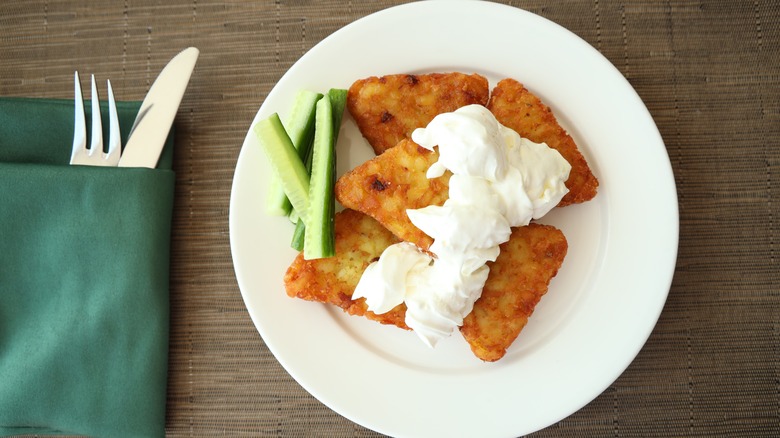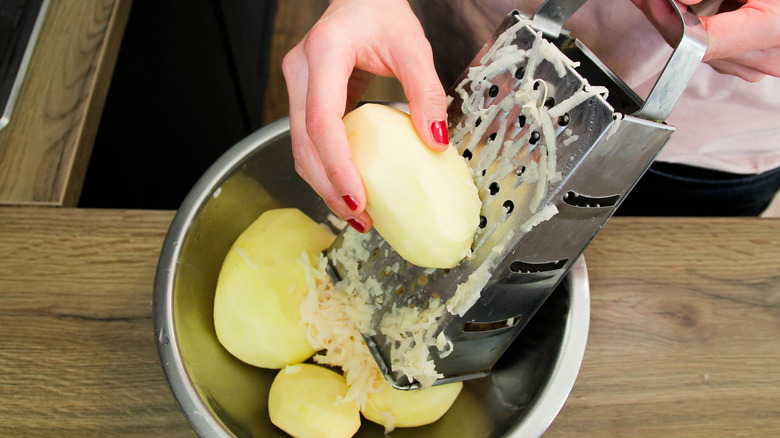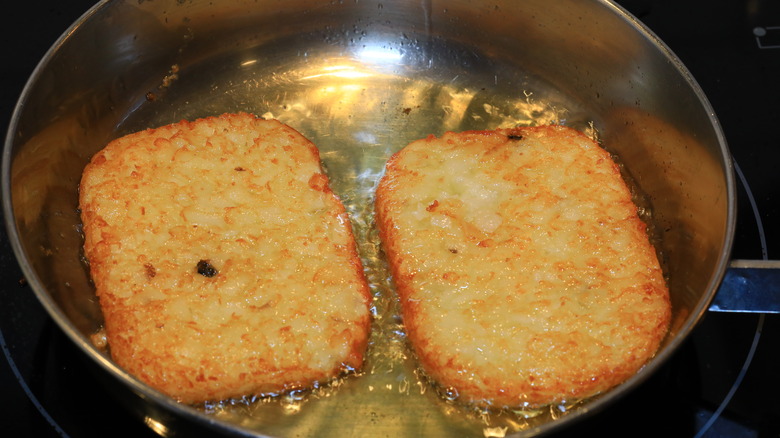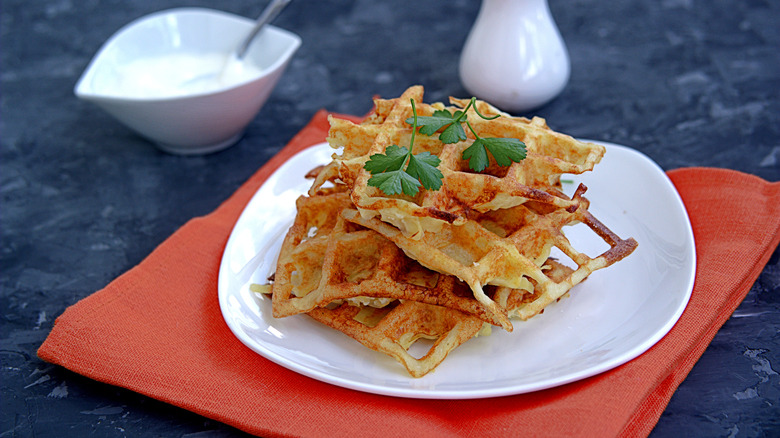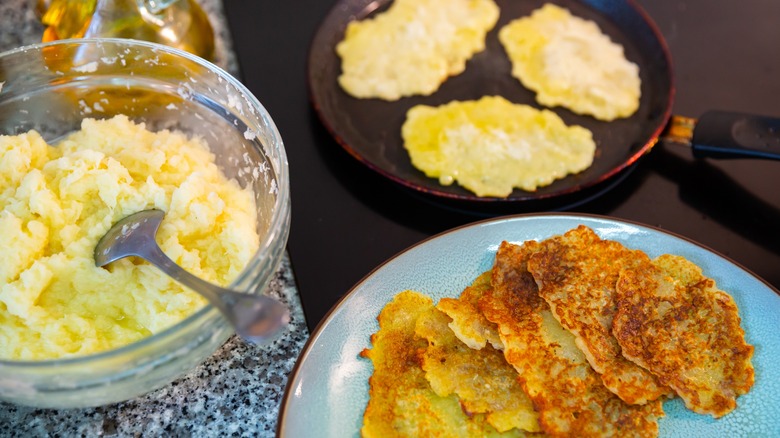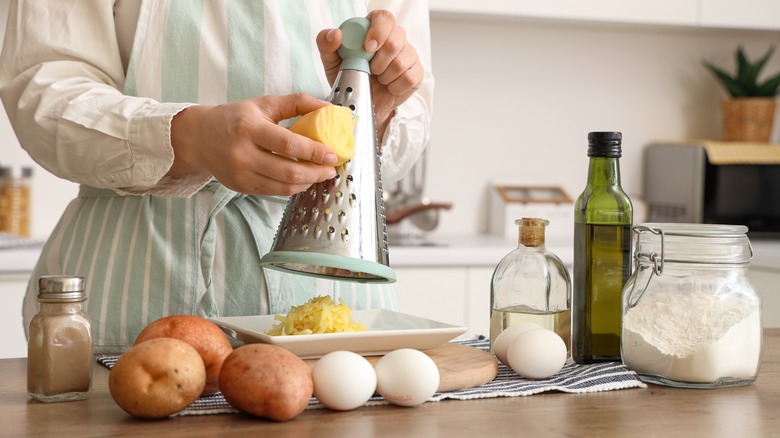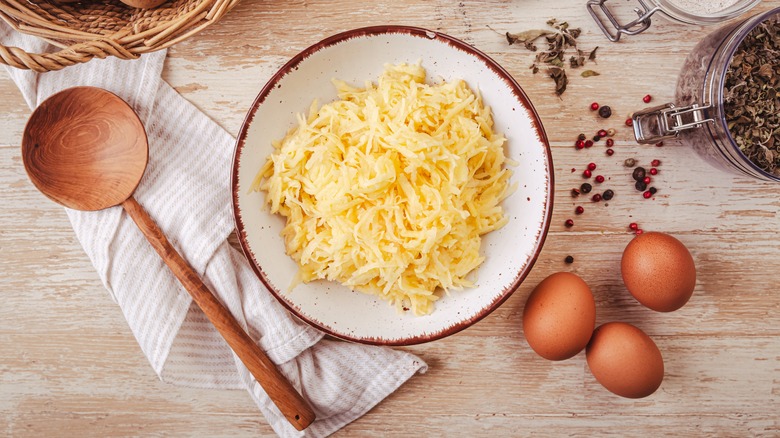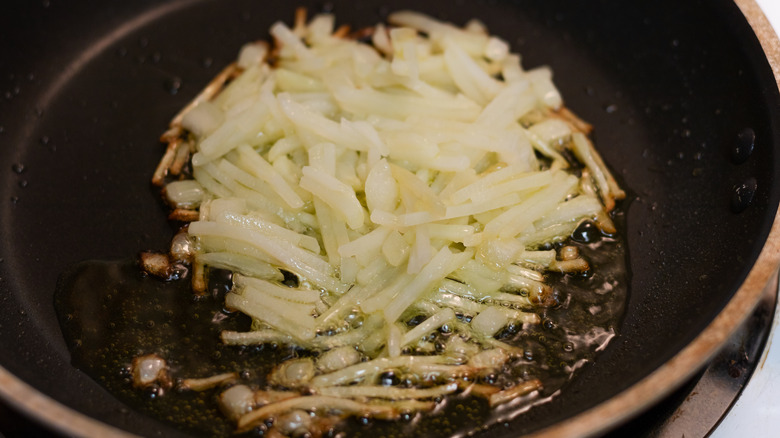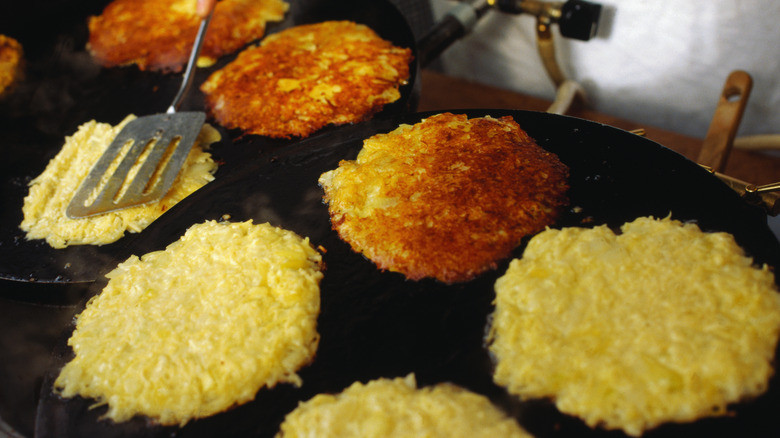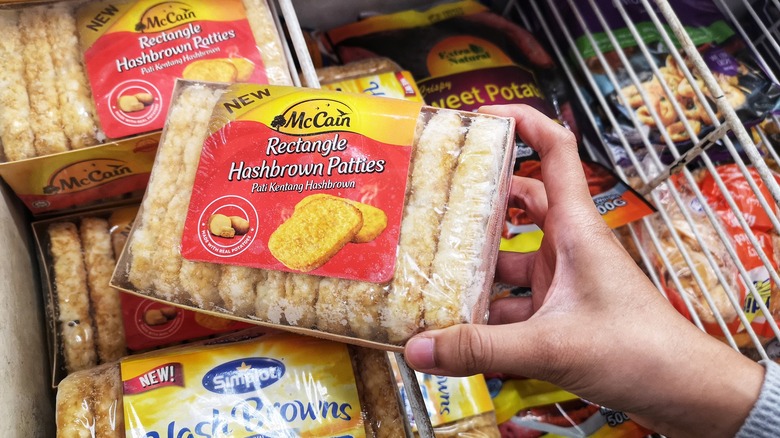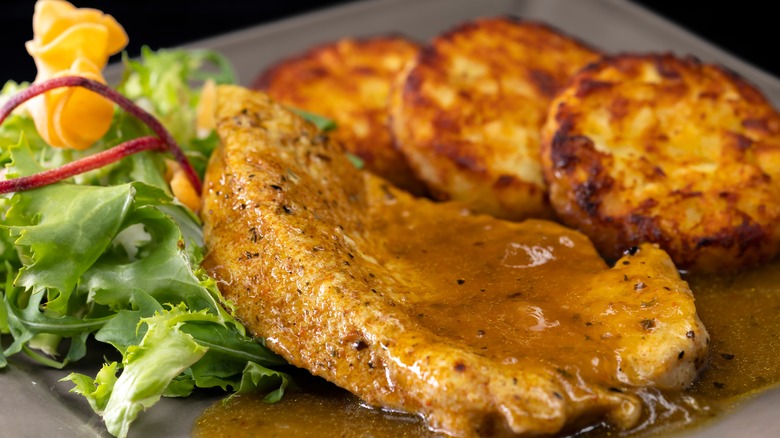10 Mistakes That Experts Say Everyone Makes When Cooking Hash Browns
Your potatoes are prepped, the oil is smoking, and your fingers are crossed. But, a few minutes later, you are left with a soggy, stubborn mess rather than the perfectly crispy golden hash browns you were dreaming of. Sound familiar? We are here to tell you that you're not alone and, even more importantly, that help is on its way.
We turned to a trio of passionate food experts to help us crack the code on what really makes or breaks a great hash brown. Ashley Schuering, the voice behind Confessions of a Grocery Addict, shares time and money-saving tips for home cooks navigating the daily hustle. Michelle Morey is a Maine-based culinary school grad and recipe developer, and the creator of a popular New England-inspired blog, Barefoot in the Pines. She brings over a decade of hands-on kitchen experience to the table. And finally, Lea Ramaswamy, Sous Chef at the Stacks Diner in Amsterdam, where the classic American diner experience is being redefined with European-sourced ingredients and from-scratch comfort food.
From choosing the wrong potatoes to flipping them too often, these blunders might be sabotaging your favorite breakfast go-to. Together, our experts dish out the biggest hash brown mistakes and what you should be doing instead for crispy success.
Not knowing your potatoes
There are potatoes, and then there are the perfect potatoes for the job. If you're after crispy, golden hash browns, the consensus is clear: reach for the good old russet. According to kitchen experts, the key to a crunchy bite is using a spud with just the right amount of starchiness. Too much starch and you are left with a gluey mess. Too little and your patties won't hold their shape. That's why russets (and to some extent Yukon Gold potatoes) are the go-to.
There's also plenty of debate online about the best potato shape for your hash browns. Some folks swear by small cubes, saying they cook evenly and are easy to flip. However, hash brown purists are all about grating potatoes into tender flakes that merge during frying to create that gorgeous, almost pancake-like finish. You can use a food processor to get perfectly even strands, but a common box grater works just as well (if a slight bit more demanding). Some insist that pre-baked potatoes work a charm, especially if you chill them in the fridge overnight. If strapped for time, a microwave does the job equally well. Hand cutting is generally not recommended because the larger surface area will never offer the golden caramelization you desire.
Choosing the wrong fat
One glaring mistake a lot of people make when frying hash browns is using the wrong kind of fat. Oils with a high smoke point, such as peanut, vegetable, or canola oil, are your best friends when frying at high temperatures. These help you get that superb char without the singe. Olive oil on its own should be avoided, as should butter. Instead, a pro move, using a mix of the two, allows you the best of both worlds. It's the ideal way to maximize the flavor of butter without burning your dish. Ashley Schuering agrees, "The oil helps increase the smoke point so you can get a nice, dark golden-brown crust, while the butter adds richness." Of course, you can always opt for indulgent choices like pork lard, bacon grease, or duck fat to elevate your simple taters to the next level. They add a depth of flavor that's hard to beat, but save these for you when you are out to impress.
While there are requests for oil-free hash browns, and you could technically make one in a good non-stick pan using spiral-sliced potatoes for maximum surface area, it's a bit of a stretch. Instead, do like Schuering and swap your pan for an air fryer. "I took two frozen hash brown patties, air fried them until crispy, and then gave them the "loaded" treatment by dolloping on Greek yogurt, bacon bits, scallions, cheddar, chives, and cracked black pepper."
Always using a pan
Frying hash browns in a pan or griddle is not the only great way to get those restaurant-worthy taters. We are here to urge you to think outside the box. You might be pleasantly surprised. First up, dust off that waffle maker you used a few times and then shelved. A waffle maker is a great way to whip up toasty, crackly potato patties. For a healthier alternative that uses little to no oil, consider using an air fryer. While the gadget undoubtedly is great for reheating leftover hash browns or cooking frozen, pre-made varieties, you may be surprised how well it handles fresh, made-from-scratch versions too. Michelle Morey concurs, "I would say the air fryer would be the better tool. It's able to get an even browning quickly, without it being greasy, and it sets the exterior fast before the whole hash brown falls apart."
Ashley Schuering adds, "I also recently expanded my pantry stash to include shelf-stable dried hash brown cartons. I was honestly shocked at how delicious they turned out! All you have to do is rehydrate them with boiling water, then you can use them however you want."
Not realizing that water is the villain
The single biggest piece of advice to take away is that moisture is the enemy of an ultimate hash brown. Lea Ramaswamy puts it best, "Water is the enemy that will turn your hash browns black from oxidation by the time you start to cook them. I've lost so many batches of hash browns to oxidation because I didn't squeeze the water out of the potatoes well enough." No matter how you prep or cut/grate your potatoes, this next step is non-negotiable. You can use paper towels, cheesecloth, nut milk bags, kitchen towels, or even a potato ricer to remove as much liquid as possible. Michelle Morey shares her pro-tips: "Par-cook your potatoes and then shred them, but before you do anything, get as much water out as possible. Then, form them and pan-fry until crispy."
To improve results, you could even sprinkle grated potatoes with salt to help draw out more moisture. A genius piece of advice is to invest in a salad spinner for a fast, efficient, and effective way to get your potatoes prepped right. Ashley Schuering adds, "I recommend using a large, clean flour-sack towel, twisting it into a tight ball, and squeezing multiple times as hard as you can. Also, feel free to save that liquid and freeze it — it's a good stand-in for pasta water (if you accidentally drain your pasta without saving some) and can add a nice body to soups and stews."
Failing to use a binder
Using an egg as a binder is an age-old trick to keep your patties from falling apart. Keep in mind that the extra moisture the egg adds only means that you'll need to squeeze the potatoes even drier than usual. Skipping on a binder is normally a recipe for disaster, but what if you are averse to eggs? Is there an alternative that works just as well?
Some experts suggest swapping in wholewheat or (gluten-free) all-purpose flour. Or, consider swapping egg or flour with grated cauliflower or dusting with a bit of cornstarch. Mixing in a little grated Parmesan also works a charm. After much experimenting, Lea Ramaswamy hit upon a recipe for hash browns that was an unmitigated success. She explains, "At first, I used baking powder in my batter for a cakier bite, but I didn't realize that it was counteracting the anti-oxidising function of the vinegar. They both cancelled each other out due to their basic/acidic nature. Took the baking powder out and now not only do I use the vinegar as a flavor agent, but it keeps my potatoes from oxidising for hours before I mix them into a batter, so I can work on other things around the kitchen."
Not pimping the potatoes with spices and herbs
Hash browns are the ultimate sidekick to sausages, eggs, beans... the whole breakfast caboodle. However, they can also be, dare we say it, a bit bland and uninspiring on their own. One way to fix this is to add your blend of spices and seasoning to the grated potato mix. Michelle Morey emphasizes the fact that "Salt is SO IMPORTANT for potatoes. It keeps the potato from being bland." You could use dried or fresh herbs and a variety of spices like paprika, garlic powder, flavored salts, and freshly ground pepper. Grated onions are also unbelievably great add-ons, adding a softer texture and a moreish flavor. According to an old Jewish tradition passed down by latke makers, grated onion also prevents premature browning. "Adding a dash of vinegar turns into a salt and vinegar vibe. Could use malt or white," suggests Lea Ramaswamy. Vinegar also helps the potatoes stick together and not fall apart when frying.
Another point to keep in mind is that the seasoning, like salt and pepper, should be finely ground to ensure that it flavors every part of the patty. Ashley Schuering concludes, "Bland is just shorthand for lacking seasoning," so my first step would be to add a decent amount of salt and additional seasonings like black pepper or garlic powder. Aside from that, I think it depends on how you plan on serving the hash browns."
Not giving the pan a warm-up
If you're using a pan, which one is the best? Chefs prefer using a hot plate or griddle to sling out orders fast. The consistent, high heat from these appliances allows for uniform grilling without the guesswork. However, if you are a home chef, using a regular pan may be your only alternative. Here's where things get divisive. Some swear by non-stick pans for the easiest way to fry your hash browns without sticking. Others are loyal to cast iron pans (that have been properly seasoned) for the smoky char you are looking for. Whichever team you are on, most people agree on one thing: Preheating your pan is the secret to superlative hash browns.
The initial blast of heat helps the outer layer of the potatoes set into a lovely, golden crust, but cooking them on high for too long will cause them to burn. On the flip side, a low, slow heat won't do your hash browns any favors. The ideal combo is to preheat your pan, add the oil, and then cook your potatoes on high for a bit before reducing to medium heat. A quick tip to figure out if your pan is the correct temperature before adding the oil is to splash a little water. If it beads immediately, it's ready for the oil. Once the added oil shimmers, drop in a small piece of bread to test. If tiny bubbles appear immediately, the oil is ready for frying.
Not giving them the space they need
One of the biggest complaints seen on online forums is that the hash browns keep breaking up when frying. Ashley Schuering advises, "You'll also want to use either a non-stick pan or a well-seasoned cast-iron skillet for the best browning. And remember: Don't touch! Once you spread the hash browns into the preheated pan, leave them undisturbed for several minutes so they have a chance to create that golden-brown crust before flipping. If you mess with them too early, you're likely to have bits that stick to the bottom of the pan while the majority of the hash browns are kind of pale and torn."
If you do find your hash browns breaking up all the time, you are moving them too much. The trick is in letting them cook and leaving them alone for a good five to seven minutes before gently flipping them over. If you do want to save your hash browns from a soggy mess, heat the oil and don't overcrowd the pan. Once you add the potato patties, press down on them lightly with a spatula (enough to ensure that the surface area is evenly in contact with the hot skillet) and just be patient.
Never giving frozen hash browns a chance
If you've read this far, you know there's a fair bit of work (and trial and error) involved in getting your hash browns just right. But what if we told you another easier way? There comes a point when choices must be made, and taking the harder road is not always the smarter option. That's why we actively encourage you to look into frozen hash browns as your new breakfast buddy. Ashley Schuering advises, "I keep both regular frozen hash browns and frozen hash brown patties in the freezer for quick meal fixes." Michelle Morey is a fan, as well, "Absolutely yay. I love a frozen hash brown all day long. Air fried would be my choice for the best crispiness."
That said, there are a few tricks to elevate your meal. These include seasoning them well to ensure a flavor kick, using butter and oil for a depth of smoky flavor, and using the oven at a moderate temperature. Lea Ramaswamy expands, "Oven on broil with fan, rack on the highest setting, flakey salt." Morey adds, "I've definitely used an oven to heat frozen hash browns. But I would say the air fryer would be the better tool. It's able to get an even browning quickly, without it being greasy, and it sets the exterior fast before the whole hash brown falls apart."
Not using them in different ways
We asked our experts, "If you had to design a restaurant dish around hash browns as the star, what would you serve with them?" and the answers were unexpected and exciting. Lea Ramaswamy recommends topping with "sour cream and trout roe with ramp oil — a classic combination and favorite at the weekly Stacks Diner brunch." Michelle Morey has a choice of tricks up her sleeve, "I would say some sort of fancy ketchup would be my first choice... But a lemon garlic aioli would be SO GOOD with a hash brown."
Ashley Schuering likes to make a meal out of her hash browns by "making a giant hash brown pancake large enough to fit a dinner plate. Next, top with some crème fraîche/greek yogurt/sour cream that's been flavored with fresh lemon zest and lemon juice, cold-smoked salmon, a jammy poached or fried egg, fresh chives/scallions or fresh or pickled red onions and, if you have access, a dollop of caviar, tobiko, or salmon roe (or capers, for a cheaper briny punch)."
The truth is there's no reason to play it safe. Hash browns offer the ideal starting point for your culinary explorations. Load them up with pulled pork or jerk chicken, go festive with sausages, gravy, and cranberry relish, or shmoosh them into a pie dish and bake as a "crust" for a quiche filling. The real crime would be having your hash browns in the same uninspired way, day after day.
